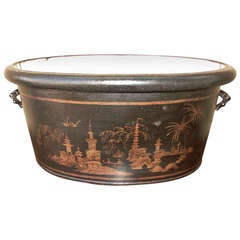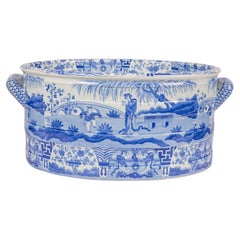Chinoiserie Footbath
Recent Sales
19th Century English Black and Gilt Tole Chinoiserie Footbath
Located in New York, NY
This black tole footbath is beautifully painted with a gilded chinoiserie design of a landscape
Category
Antique 19th Century English Vases and Vessels
Materials
Metal
Blue and White Footbath Made by Spode in Chinoiserie Style Circa 1820
By Josiah Spode
Located in Katonah, NY
We are pleased to offer this beautiful blue and white footbath made by Spode and decorated in their
Category
Antique Early 19th Century English Chinoiserie Planters and Jardinieres
Materials
Earthenware
Vintage Rose Medallion FootBath Asian Centerpiece
Located in Fort Washington, MD
Stunning vintage Rose Medallion Hand Painted Porcelain Footbath with wooden stand.
This footbath
Category
Mid-20th Century Chinese Chinoiserie Planters, Cachepots and Jardinières
Materials
Porcelain, Paint
Chinese Porcelain Hand Painted Monkey Fish Footbath Planter Jardinière Cache Pot
Located in Dayton, OH
Beautiful vintage Chinese foot bath with climbing monkeys and innet fish motif, circa last quarter 20th century. Made from porcelain with a polychrome finish and gold plated handles....
Category
Late 20th Century Chinoiserie Planters, Cachepots and Jardinières
Materials
Porcelain
H 8.25 in W 22 in D 14.5 in
Get Updated with New Arrivals
Save "Chinoiserie Footbath", and we’ll notify you when there are new listings in this category.
More Ways To Browse
Porcelain Footbath
Monkey Planter
Blue And White Footbaths
China Foot Bath
Chinese Foot Bath
Footbath Blue White
Monkey Jardiniere
Rose Medallion Cachepot
Chinese Footbath
Spode Footbath
Fertility Vase
Fifties Sixties Seventies
Fish Vase Michael Harris
Flavio Poli Vase Amber Green
Flemish Pottery
Floor Pink Vase
Floor Vase On Stand
Florence Barlow

